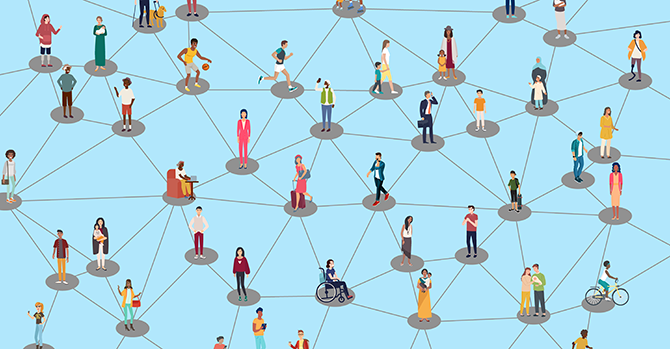Students Support Campus COVID-19 Response with Contact Tracing

A group of University of Michigan students is experiencing public health practice firsthand while working as contact tracers as part of the university’s response to the COVID-19 pandemic.
The Contact Tracing Corps, developed by the University of Michigan School of Public Health, is a team of over 50 students across the health sciences schools who receive specialized training to conduct duties such as student outreach, monitoring, and needs coordination for students who contract—or come into contact with someone who contracted—COVID-19. This corps collaborates with university and local partners to conduct this work, including the University of Michigan Department of Environment, Health & Safety and the Washtenaw County Health Department among others.
“The student contact tracers are a critical component of this highly collaborative, complex system as we aim to keep our community safe during the pandemic,” said Angela Beck, associate dean for student engagement and practice at Michigan Public Health.
Incoming Call: Contact Tracer
Payal Patel, a master’s student studying Epidemiology at the School of Public Health, works as a contact tracing volunteer where she calls university students who are exposed to COVID-19 in order to ensure that students have the resources they need as they transition into their 14 day quarantine.
“Working with the Contact Tracing Corps was the best way I felt I could help keep the community safe in this time of need,” Patel said. “There aren’t a lot of volunteering opportunities right now because of COVID-19 and this offered me a way to provide assistance.”
Patel, who volunteers for the program about 8 hours each week, says that working as a contact tracer gave her a new perspective on preventing the spread of COVID-19.
“I don’t think many people think of contact tracers as frontline workers,” she said.” We may not be the ones treating you in a hospital setting when you’re sick, but we’re the people who provide those exposed to COVID-19 the resources they need to prevent further community spread.”
Getting Quarantined Students the Resources They Need
“I knew that I wanted to be involved in the COVID-19 response, especially when I moved back to Ann Arbor,” said Elizabeth MacDonald, a master’s student in Epidemiology at Michigan Public Health.
Working as a communications lead, MacDonald spends much of her time on the Contact Tracing Corps coordinating with various partners at the university to supply the resources that students need during their quarantine period.
“No student has the same circumstances for their quarantine, so my job is to collaborate with our contact tracing callers and our university partners to make sure that we can effectively get the student everything they need,” MacDonald said.
Resources such as transportation, food, and academic and mental health support can all be facilitated through the contact tracers. “Not every student has a car, so we need to help get them to their quarantine space,” MacDonald said. “Some students need academic support during their 14 days. Our partners are instrumental in supporting these requests.”
Communicating COVID-19 Effectively
Both Patel and MacDonald express the need to not only understand the data and science behind COVID-19, but also how to disseminate that information to someone who may not have a background in public health.
“The pandemic has made me think a lot about public health communication and the need to share complex information in a way that many people can understand,” MacDonald said. “The public health communications classes I’ve taken have really provided me with a foundation to improve my communication skills and put them into practice.”
“Not every student is an expert on the coronavirus. Being a contact tracer helped me to develop a COVID-19 elevator speech,” Patel said. “I want anyone who I’m contacting to be able to understand what COVID-19 is, why it’s important to quarantine, and how they can get the resources they need.”
- Learn more about Epidemiology at Michigan Public Health.
- Read more about the coronavirus from Michigan Public Health.
